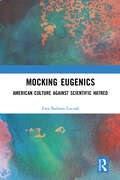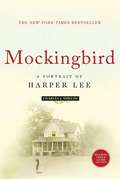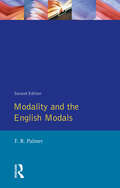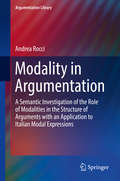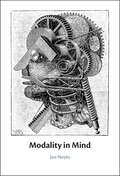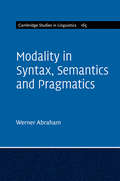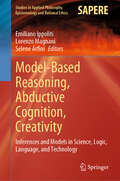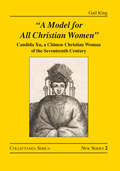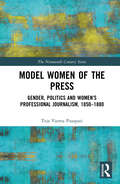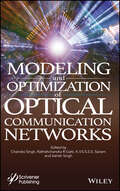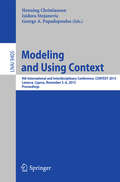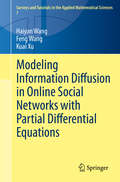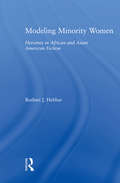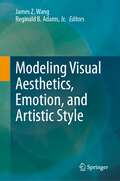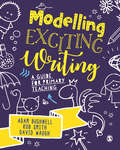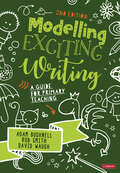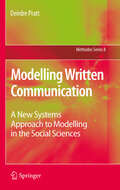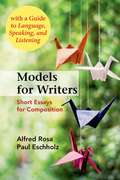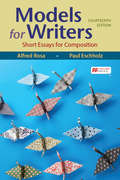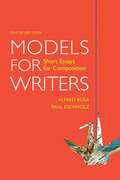- Table View
- List View
Mocking Eugenics: American Culture against Scientific Hatred
by Ewa Barbara LuczakMocking Eugenics explores the opposition to eugenic discourse mounted by twentieth-century American artists seeking to challenge and destabilize what they viewed as a dangerous body of thought. Focusing on their wielding of humor to attack the contemporaneous science of heredity and the totalitarian impulse informing it, this book confronts the conflict between eugenic theories presented as grounded in scientific and metaphysical truth and the satirical treatment of eugenics as not only absurdly illogical but also antithetical to democratic ideals and inimical to humanistic values. Through analyses of the films of Charlie Chaplin and the fiction of F. Scott Fitzgerald, Ernest Hemingway, Anita Loos, and Wallace Thurman, Mocking Eugenics examines their use of laughter to dismantle the rhetoric of perfectionism, white supremacy, and nativism that shaped mainstream expressions of American patriotism and normative white masculinity. As such, it will appeal to scholars of cultural studies, literature, cinema, sociology, humor, and American studies.
Mockingbird: A Portrait of Harper Lee
by Charles J. ShieldsTo Kill a Mockingbird--the twentieth century's most widely read American novel--has sold thirty million copies and still sells a million yearly. Yet despite her book's perennial popularity, its creator, Harper Lee, has become a somewhat mysterious figure. Now, after years of research, Charles J. Shields brings to life the warmhearted, high-spirited, and occasionally hardheaded woman who gave us two of American literature's most unforgettable characters--Atticus Finch and his daughter, Scout. At the center of Shields's evocative, lively book is the story of Lee's struggle to create her famous novel, but her colorful life contains many highlights--her girlhood as a tomboy in overalls in tiny Monroeville, Alabama; the murder trial that made her beloved father's reputation and inspired her great work; her journey to Kansas as Truman Capote's ally and research assistant to help report the story ofIn Cold Blood. Mockingbird--unique, highly entertaining, filled with humor and heart--is a wide-ranging, idiosyncratic portrait of a writer, her dream, and the place and people whom she made immortal.
Modality and Propositional Attitudes
by Michael HegartyThis book shows that the semantic analysis of modal notions of possibility and necessity can be used to enhance our understanding of the interpretation of reports of belief or emotional state. It introduces intuitive notation and terminology to express ideas in modern theories of modal interpretation that are normally represented in complex logical formulas, effectively updates the 1960s-era link between possible worlds and the semantics of propositional attitude ascriptions, and reconciles two disparate views of the role of events in semantic interpretation, that of Donald Davidson and that of David Lewis. It reduces a host of variable behaviors of propositional attitude ascription to an intuitive and precise distinction between ascriptions that merely express a commitment to propositional content versus ones that attribute a mental state to the holder of the propositional attitude. This leads to an explanation of the nature and effects of the language disorder of fluent aphasia.
Modality and the English Modals (Longman Linguistics Library)
by F. R. PalmerA detailed account of the many uses and functions of these verbs. The nature of modality, and some controversial issues, are also discussed.
Modality in Argumentation
by Andrea RocciThis book addresses two related questions that have first arisen in Toulmin's seminal book on the uses of argument. The first question is the one of the relationship between the semantic analysis of modality and the structure of arguments. The second question is the one of the distinctive place, or role, of modality in the fundamental structure of arguments. These two questions concern how modality, as a semantic category, relates to the fundamental structure of arguments. The book addresses modality and argumentation also according to another perspective by looking at how different linguistic modal expressions may be taken as argumentative indicators. It explores the role of modal expressions as argumentative indicators by using the Italian modal system as a case study. At the same time, it uses predictions/forecasts in the business-financial daily press to investigate the relation between modality and the context of argumentation.
Modality in Mind
by Jan NuytsModality – the ways in which language can express grades of reality or truth – is the subject of a vast and long-established body of research. In this book, field-leader Jan Nuyts brings together twenty years of his research to offer a comprehensive, fully integrated view on areas of contentious debate within modality, from a functional and cognitive perspective. The book provides an empirically grounded, conceptual reanalysis of modality and related categories including evidentiality, volition, intention, directivity, subjectivity and mirativity. It argues for the dissolution of the category of modality and for an alternative division of the wider field of semantic notions at stake. The analysis also reflects on how to model the language faculty, and on the issue of language and thought. It is essential reading for researchers interested in the semantics of modality and in the implications of this domain for understanding the cognitive infrastructure for language and thought.
Modality in Syntax, Semantics and Pragmatics (Cambridge Studies in Linguistics #165)
by Werner AbrahamWhat do we mean when we say things like 'If only we knew what he was up to!' Clearly this is more than just a message, or a question to our addressee. We are expressing simultaneously that we don't know, and also that we wish to know. Several modes of encoding contribute to such modalities of expression: word order, subordinating subjunctions, sentences that are subordinated but nevertheless occur autonomously, and attitudinal discourse adverbs which, far beyond lexical adverbials of modality, allow the speaker and the listener to presuppose full agreement, partial agreement under presupposed conditions, or negotiation of common ground. This state of the art survey proposes a new model of modality, drawing on data from a variety of Germanic and Slavic languages to find out what is cross-linguistically universal about modality, and to argue that it is a constitutive part of human cognition.
Model-Based Reasoning, Abductive Cognition, Creativity: Inferences and Models in Science, Logic, Language, and Technology (Studies in Applied Philosophy, Epistemology and Rational Ethics #70)
by Emiliano Ippoliti Lorenzo Magnani Selene ArfiniThis book discusses how scientific and other types of cognition make use of models, abduction, and explanatory reasoning in order to produce important, innovative, and possibly creative changes in theories and concepts. Gathering revised contributions presented at the international conference on Model-Based Reasoning (MBR023), held on June 7–9, 2023 in Rome, Italy, the book addresses various intertwined topics ranging from the epistemology and applications of models also concerning the problem of knowledge production and scientific methodology (information visualization, experimental methods, and design) to the analysis of their role in cognition, decision-making, also with respect to social implications. The problem of model-based cognition is also illustrated taking advantage of recent results regarding problem-solving, abduction, and logic, paying attention to a critique of the dominant and received approaches, to the aim of fostering new discussions and stimulate new ideas. All in all, the book provides researchers and graduate students in the fields of applied philosophy, epistemology, cognitive science, and artificial intelligence alike with an authoritative snapshot of the latest theories and applications of model-based reasoning.
"A Model for All Christian Women": Candida Xu, a Chinese Christian Woman of the Seventeenth Century (Collectanea Serica. New Series #2)
by Gail KingThis biography of Candida Xu (1607–1680), granddaughter of the prominent Chinese Christian convert and statesman Xu Guangqi (1562–1633) and foremost Chinese Christian woman of the seventeenth century, is based on the biography of Candida Xu titled Histoire d’une dame chrétienne de la Chine (Paris, 1688) written by her confessor Philippe Couplet, S.J. (1623–1693), an obituary of his mother and other writings by her eldest son, and the Xu family history. Using these as well as other relevant European missionary and Chinese language sources, Candida Xu’s life as daughter, wife, mother, and generous contributor to the Christian Church is recounted. Events in her life are set in the context of historical and religious circumstances in China at the time. Consideration of the situation of women, particularly Christian women, draws out how Candida Xu’s faith helped her and other believing Christian women to gain greater freedom of choice and action.
The Model of Poesy
by William Scott Gavin AlexanderThe Model of Poesy is one of the most exciting literary discoveries of recent years. A manuscript treatise on poetics written by William Scott in 1599, at the end of the most revolutionary decade in English literary history, it includes rich discussions of the works of Sidney, Spenser, Shakespeare and their contemporaries. Scott's work presents a powerful and coherent theoretical account of all aspects of poetics, from the nature of representation to the rules of versification, with a commitment to relating theory to contemporary practice. For Scott, any theory of literature must make sense not of the classics but of what English writers are doing now: Scott is at the same time the most scholarly and the most relevant of English Renaissance critics. In this groundbreaking edition, Gavin Alexander presents a text of The Model of Poesy framed by a detailed introduction and an extensive commentary, which together demonstrate the range and value of Scott's thought.
Model Women of the Press: Gender, Politics and Women’s Professional Journalism, 1850–1880 (The Nineteenth Century Series)
by Teja Varma PusapatiThis book offers the first extended account of the mid-century rise of ‘model women of the press’: women who not only stormed the male bastions of social and political journalism but also presented themselves as upholders of the highest standards of professional journalistic practice. They broke the codes of anonymity in several ways, including signing articles in their own names and developing distinctly female personae. They proved, by example, women’s fitness for conventionally masculine lines of journalism. By placing Victorian women’s serious, high-minded journalism firmly within the context of ‘the widening sphere’ of female professions in mid-nineteenth-century England, the book shows how a wide range of women writers, including leading Victorian feminists and female reformers, contributed to the professionalization of women’s authorship. Drawing on extensive archival research and close analysis of a wide range of printed texts, from Victorian newspapers and periodicals to autobiographies, memoirs, and fiction, this book elucidates several aspects of Victorian women’s journalism that have been previously ignored: the market interest of the feminist English Woman’s Journal; the ability of women like Eliza Meteyard and Frances Power Cobbe to write consistently on serious social and political issues in mainstream periodicals; Harriet Ward’s astonishing reportage from the war fields of South Africa; and Harriet Martineau’s reports on Famine-devastated Ireland and her role as a transatlantic commentator on American abolitionism. The study also offers the first focused account of the figure of the female professional journalist in Victorian novels, showing how these texts move away from the dominant myth of the author as a solitary genius to present the female journalist as a collaborator who adapts her writing to fit various newspapers and periodicals, and works closely with male editors and peers. In examining the rise of the Victorian woman writer as a serious social and political journalist, this book adds to current critical understanding of female political expression, authorial agency, and cultural authority in nineteenth-century England.
Modeling and Optimization of Optical Communication Networks
by Chandra Singh Rathishchandra R. Gatti K.V.S.S.S.S. Sairam Ashish SinghMODELING and OPTIMIZATION of OPTICAL COMMUNICATION NETWORKS Optical networks are an integral part of many of the technologies that we use every day. It is a constantly changing and evolving area, with new materials, processes, and applications coming online almost daily. This book provides a basis for discussing open principles, methods and research problems in the modeling of optical communication networks. It also provides a systematic overview of the state-of-the-art research efforts and potential research directions dealing with optical communication metworks. It also simultaneously focuses on extending the limits of currently used systems encompassing optical and wireless domains and explores novel research on wireless and optical techniques and systems, describing practical implementation activities, results and issues. A handbook on applications for both academia and industry, this exciting new volume includes detailed discussions on real-world case studies on trends and emerging technologies associated with modeling of optical communication networks. This book also describes several numerical models and algorithms for simulation and optimization of optical communication networks. Modeling and optimization presents several opportunities for automating operations and introducing intelligent decision making in network planning and in dynamic control and management of network resources, including issues like connection establishment, self-configuration, and self-optimization, through prediction and estimation by utilizing present network state and historical data. It focuses on extending the limits of currently used systems encompassing optical and wireless domains, and explores the latest developments in applications like photonics, high speed communication systems and networks, visible light communication, nano-photonics, wireless, and MIMO systems.
Modeling and Using Context
by Henning Christiansen Isidora Stojanovic George A. PapadopoulosThis book constitutes the proceedings of the 9thInternational and Interdisciplinary Conference on Modeling and Using Context,CONTEXT 2015, held in Larnaca, Cyprus, in November 2015. The 33 full papers and 13 short papers presented werecarefully reviewed and selected from 91 submissions. The main theme of CONTEXT2015 was "Back to the roots", focusing on the importance ofinterdisciplinary cooperations and studies of the phenomenon. Context, contextmodeling and context comprehension are central topics in linguistics,philosophy, sociology, artificial intelligence, computer science, art, law,organizational sciences, cognitive science, psychology, etc. and are alsoessential for the effectiveness of modern, complex and distributed softwaresystems. CONTEXT 2015 embedded also a Doctoral Symposium, andthree workshops; Smart University 3. 0; CATI: Context Awareness and TactileDesign for Mobile Interaction; and SHAPES 3. 0: The Shape of Things.
Modeling Citizenship: Jewish and Asian American Writing
by Cathy Schlund-VialsNavigating deftly among historical and literary readings, Cathy Schlund-Vials examines the analogous yet divergent experiences of Asian Americans and Jewish Americans in Modeling Citizenship. She investigates how these model minority groups are shaped by the shifting terrain of naturalization law and immigration policy, using the lens of naturalization, not assimilation, to underscore questions of nation-state affiliation and sense of belonging. Modeling Citizenship examines fiction, memoir, and drama to reflect on how the logic of naturalization has operated at discrete moments in the twentieth century. Each chapter focuses on two exemplary literary works. For example, Schlund-Vials shows how Mary Antin's Jewish-themed play The Promised Land is reworked into a more contemporary Chinese American context in Gish Jen's Mona in the Promised Land. In her compelling analysis, Schlund-Vials amplifies the structural, cultural, and historical significance of these works and the themes they address.
Modeling Information Diffusion in Online Social Networks with Partial Differential Equations (Surveys and Tutorials in the Applied Mathematical Sciences #7)
by Feng Wang Haiyan Wang Kuai XuThe book lies at the interface of mathematics, social media analysis, and data science. Its authors aim to introduce a new dynamic modeling approach to the use of partial differential equations for describing information diffusion over online social networks. The eigenvalues and eigenvectors of the Laplacian matrix for the underlying social network are used to find communities (clusters) of online users. Once these clusters are embedded in a Euclidean space, the mathematical models, which are reaction-diffusion equations, are developed based on intuitive social distances between clusters within the Euclidean space. The models are validated with data from major social media such as Twitter. In addition, mathematical analysis of these models is applied, revealing insights into information flow on social media. Two applications with geocoded Twitter data are included in the book: one describing the social movement in Twitter during the Egyptian revolution in 2011 and another predicting influenza prevalence. The new approach advocates a paradigm shift for modeling information diffusion in online social networks and lays the theoretical groundwork for many spatio-temporal modeling problems in the big-data era.
Modeling Minority Women: Heroines in African and Asian American Fiction (Studies in Asian Americans)
by Reshmi J. HebbarThis powerful study reconceptualizes ideas of ethnic literature while investigating the construction of ethnic heroines, shifting the focus away from cultural politics and considering instead narrative or poetic qualities which involve surprising relationships between Anglo-American women's writing and fiction produced by Asian American and African American women authors.
Modeling Visual Aesthetics, Emotion, and Artistic Style
by James Z. Wang Reginald B. Adams Jr.Modeling Visual Aesthetics, Emotion, and Artistic Style offers a comprehensive exploration of the increasingly significant topic of the complex interplay between human perception and digital technology. It embodies the cumulative knowledge and efforts of a wide array of active researchers and practitioners from diverse fields including computer vision, affective computing, robotics, psychology, data mining, machine learning, art history, and movement analysis. This volume seeks to address the profound and challenging research questions related to the computational modeling and analysis of visual aesthetics, emotions, and artistic style, vital components of the human experience that are increasingly relevant in our digitally connected world. The book's vast scope encompasses a broad range of topics. The initial chapters lay a strong foundation with background knowledge on emotion models and machine learning, which then transitions into exploring social visual perception in humans and its technological applications. Readers will uncover the psychological and neurological foundations of social and emotional perception from faces and bodies. Subsequent sections broaden this understanding to include technology's role in detecting discrete and subtle emotional expressions, examining facial neutrality, and including research contexts that involve children as well as adults. Furthermore, the book illuminates the dynamic intersection of art and technology, the language of photography, the relationship between breath-driven robotic performances and human dance, and the application of machine learning in analyzing artistic styles. This book sets itself apart with its unique multidisciplinary approach, encouraging collaboration across related domains. Packed with comprehensive tutorials, theoretical reviews, novel methodologies, empirical investigations, and comparative analyses, the book offers a rich combination of knowledge and methodologies. The book's focus on cutting-edge research not only presents the latest developments in the field but also illuminates potential paths that can lead to significant advancements in computer and robotic applications.
Modelling Exciting Writing: A guide for primary teaching
by Adam Bushnell Rob Smith David WaughIn order to teach writing effectively, teachers must be able to model writing effectively to children. The Primary National Curriculum sets challenging expectations for the teaching of writing. Children must master the process of composition, redrafting, editing and writing final pieces. Increased emphasis on spelling, punctuation and grammar may leave some teachers and trainee teachers lacking ideas for developing children's writing beyond transcription and into composition. It is important that they are able to demonstrate their knowledge and understanding, as well as the practical applications of both transcriptional and compositional aspects of writing.
Modelling Exciting Writing: A guide for primary teaching
by Adam Bushnell Rob Smith David WaughIn order to teach writing effectively, teachers must be able to model writing effectively to children. The Primary National Curriculum sets challenging expectations for the teaching of writing. Children must master the process of composition, redrafting, editing and writing final pieces. Increased emphasis on spelling, punctuation and grammar may leave some teachers and trainee teachers lacking ideas for developing children's writing beyond transcription and into composition. It is important that they are able to demonstrate their knowledge and understanding, as well as the practical applications of both transcriptional and compositional aspects of writing.
Modelling Exciting Writing: A guide for primary teaching
by Adam Bushnell Rob Smith David WaughThe Primary National Curriculum sets challenging expectations for the teaching of writing. Children must master the process of composition, redrafting, editing and writing final pieces. The book: *Provides practical advice for the teaching of writing *Demonstrates how to model writing for children *Includes examples of good classroom practice of modelling writing *Focuses on writing in different aspects of the curriculum *Provides guidance, case studies and theoretical perspectives to show readers how they can become writers with and for children The updated second edition includes: *Ideas for discussion in a seminar/staff meeting/CPD event *A new chapter enabling teachers to support children to bring their own cultures and ethnicities into their writing
Modelling Exciting Writing: A guide for primary teaching
by Adam Bushnell Rob Smith David WaughThe Primary National Curriculum sets challenging expectations for the teaching of writing. Children must master the process of composition, redrafting, editing and writing final pieces. The book: *Provides practical advice for the teaching of writing *Demonstrates how to model writing for children *Includes examples of good classroom practice of modelling writing *Focuses on writing in different aspects of the curriculum *Provides guidance, case studies and theoretical perspectives to show readers how they can become writers with and for children The updated second edition includes: *Ideas for discussion in a seminar/staff meeting/CPD event *A new chapter enabling teachers to support children to bring their own cultures and ethnicities into their writing
Modelling Written Communication
by Deirdre PrattThis book offers an alternative view to current postmodern approaches to composition. It takes a critical realist stance to arrive at the "essence" of written communication with the aim of informing a practical application: a computerised writing tutor. Following Robert Franck's seminal work on modelling, a theoretical model of writing was first formulated, consisting of an architecture of functions which constitute the prerequisites for effective communication. Next, an applied model - a composing algorithm with an input option - was developed, showing composing to be a systemic social process with intra- and extra-systemic variation. The algorithm provided the design template for a writing tutor program which models for the learner both the systemic and the socially situated nature of writing. This book establishes composing as a communicative interaction, and shows the essential dynamism of writing, while offering an exemplar of a systems approach to modelling in the social sciences.
Models for Writers: Short Essays for Composition (12th edition)
by Alfred Rosa Paul EschholzModels for Writers is designed to help you learn to write by providing you with a collection of model essays--that is, essays that are examples of good writing.
Models for Writers: Short Essays for Composition
by Alfred Rosa Paul EschholzModels for Writers provides brief, compelling readings similar in length to the essays you’ll be assigned to write in college. Step-by-step advice for writing includes definition, compare and contrast, and more, with additional coverage of the elements of the essay, using sources, and research papers.
Models for Writers: Short Essays for Composition
by Alfred Rosa Paul EschholzIt’s a simple, best-selling combination that has worked for over 20 years — short, accessible essays and helpful, thorough writing instruction. Models for Writerscontinues to offer thought-provoking selections organized to demonstrate not only the rhetorical patterns that students will use in their own essays but also the elements and language that will make those essays effective.
